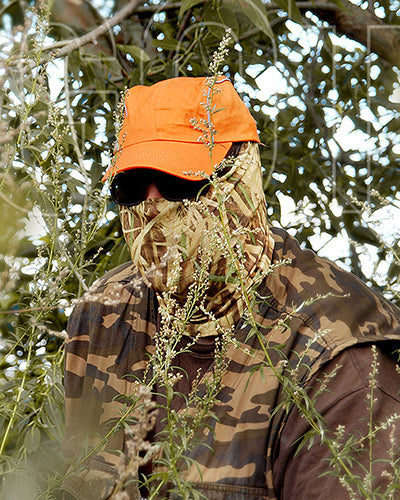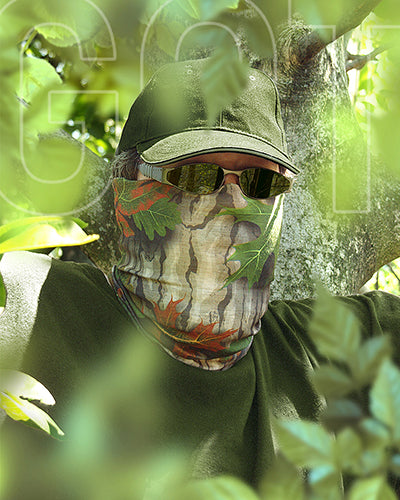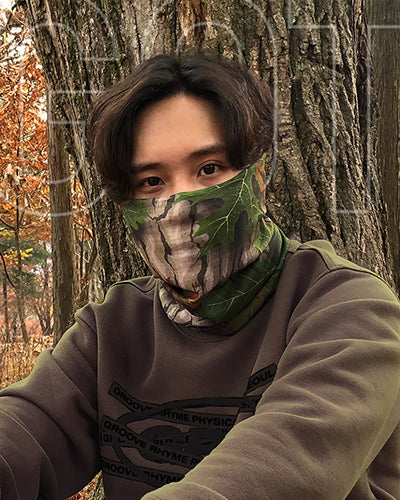Types of camouflage patterns. Style and Function.
Camo pattern clothing is likely something you've seen, worn, or heard of. While it originated around 100 years ago, the style has evolved significantly and can now even be found in designer clothing. This abstract pattern serves both a functional purpose in military, tactical, airsoft, shooting, and hunting sports, as well as being a fashionable item that can be incorporated into your everyday outfit.
Let's explore the fascinating history of camo patterns, including their origins and different variations. We'll also discuss how to match camo with other clothing items.
Just click/tap on the links below to jump to the desired section:
1. What is camouflage?
2. Countries you're banned to wear camo clothing
3. When was the camo pattern created?
4. How camo patterns deceive the eye
5. Types of camouflage patterns (man-made)
Looking over 3 categories: Classic Disruptive Camo, Disguise Camo, and Fashion
1. Define and explain camouflage
First off, the correct spelling is “camouflage”, not “camoflage”, “camoflauge” or “camoflague”, because the word comes from the French “camoufler” – to disguise, which derived from the Italian word “camuffare” – disguise, deceive.
Informally, we can use “camo”, that’s short for “camouflage”.
As the dictionary explains, “to camouflage” is to conceal a human and/or an object, and make them look like they’re part of the environment.
So the main purpose of camouflage is to deceive the eye and make it appear as if there is nothing there.
This is achieved through a combination of illumination, materials, or colors, making things harder to see, or making them look like something else.
2. Countries where you can't wear or possess camo printed clothing
It's important to remember that when traveling to certain destinations, both tourists and locals are required to follow a strict dress code imposed by the authorities, otherwise legal repercussions can occur.
From what we searched over the web, the nations that interdict civilians wearing or possessing camouflage print clothing are the following:
Azerbaijan, Antigua and Barbuda, Bahamas, Barbados, Dominica, Ghana, Grenada, Jamaica, Kenya, Nigeria, Oman, Philippines (uniforms only), Saint Lucia, Saint Vincent and the Grenadines, Saudi Arabia, South Africa, Tanzania, Trinidad and Tobago, Uganda, Zambia, Zimbabwe
This dress code regulation is enforced to avoid confusion with the country's military personnel.
So if you're planning to visit any of these countries, it's best to leave your camo clothes at home to avoid any legal complications. Also before traveling anywhere, make sure to check the dress code regulations of the country you're visiting to avoid any potential fines or penalties.
3. Short history of how the camo pattern came to the world
Man's need to blend in with the environment is not a recent phenomenon. History reports that in the 19th century, the use of solid color uniforms by some countries was prevalent. It was only during World War I (WWI) that the need for camouflage to conceal troops and equipment became a priority.
The first country to develop camouflage was France, which invested in the creation of a dedicated camouflage unit. Around 1915, artists and theatre set designers were employed to come up with techniques for hiding objects, vehicles, and buildings. In the following years, the British and Americans also began to develop various camouflage methods.
British zoologist Hugh Bamford Cott and Sir Edward Bagnall Poulton researched how camouflage worked in nature. Hugg B. Cott applied his study and observations to tactical camouflage during WW1 as a camouflage expert and in WW2 as a camouflage instructor.

Telo Mimetico
Image source: Wikipedia
The first camo pattern printed was the Italian "telo mimetico", consisting in irregular shapes and 3 colors.
Introduced in 1929, discontinued in the 1990s and replaced by something similar to the U.S. Woodland, "Telo Mimetico" was the first camouflage pattern printed for general issue and had the longest continuous use in the world, spanning over 60 years.
In the U.S., during WW1, painters like Abbott Thayer, George DeForest Brush, and Barry Faulkner worked to convince the military to adopt principles of illumination and coloration to disguise ships, weapons, and troops.
Abbott H. Thayer is sometimes named the "father of camouflage", even if he did not invent the concept of camouflage, as he was the first to write mainly about countershading, but also about distractive marks and disruptive patterns.
But how does camouflage actually work? Keep on reading to find out!
4. Hidden in plain sight...
When we look around, our mind interprets the world and breaks it into separate objects, such as trees, rocks, bushes, leaves, and so on. If there is no obvious separation within an object, like a bright red color in the middle of a tree, then we see it as continuity.
Nature provides many examples of animals and insects that use camouflage to blend in with their surroundings, either to avoid being spotted by prey or to protect themselves from predators. Their colors and shapes help them to be less visible and more difficult to detect.



All camouflage principles mentioned in chapter 3 (countershading, distractive marks, and disruptive patterns) are based on Thayer’s observation of animals, reptiles, birds, and insects.
Using the disruptive method, classic camouflage clothes help conceal and blend a person or object with their surroundings.
Jungle and forest camo are usually green and brown, matching the leaves and dirt. Desert camo uses a variation of tan colors, while snow camo is typically either white or with both white and gray.
And while matching the colors of the surrounding environment is important, the most significant part of printed camouflage is the pattern, in which the elements are mixed to visually interrupt what we see, hiding the body's contour.
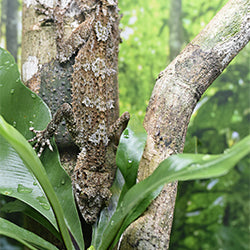



Our brain instinctively links the lines of the pattern’s colored elements with the lines of the habitat, such as shadows, trees, ground, leaves, etc., affecting our ability to notice and identify the camouflaged person or object.
This principle is called disruptive camouflage, disruptive pattern, disruptive coloration, which is represented by highly contrasting marks, like spots or stripes, breaking up the edges of what you want to hide.
5. Man made Camouflage patterns
Camouflage designs have undergone significant changes over the years, almost as much as fashion trends. Although various patterns have come and gone, some styles have entered and conquered the market, with customers using them for tactical sports or everyday attire.
We'll take a look at some of the patterns that we can include in Disruptive Camo, Disguise Camo, and Fashion.
Classic Disruptive Camo
The most popular patterns in this category are Jigsaw, Tiger stripe, Leaf, Woodland, and Digital / Pixel.

Image source: Wikipedia
Jigsaw camouflage
This design was used between 1956 and 2022 by the Belgian Armed Forces and later adapted in other countries.
Sometimes called Puzzle, the pattern's elements resemble the pieces of a classic Jigsaw Puzzle game, although the pattern’s shapes overlap.
Image source: Wikipedia
Tiger stripe camouflage
We could not find who first developed this pattern, but we know it was used around 1962 and still exists.
The name comes from the pattern's similarity to a tiger’s stripes.
It features narrow and broader stripes, that look like brushstrokes that interlock rather than overlap.
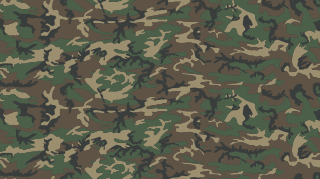
Image source: Wikipedia
Leaf camouflage
Also known as ERDL, this pattern was developed by the U.S. Army in 1948 and used until the early 1980s.In the late 1960s, the camo pattern was copied and printed on unofficial and commercial clothes.
This design might have gotten the informal name “leaf camo” due to its interlocking shapes that resemble black branches with leaves.

Image source: Wikipedia
U.S. Woodland camouflage
If you have looked back up to Leaf camo, we get it, and no, it’s not an error :))
This pattern replaced the ERDL, and it’s almost the same as the one before, except for some tweaks: the design was enlarged, and the edges of the elements were made more irregular.
Digital camouflage

Also known as pixel camo, this design gets its name from its similarity with the first computer graphics, in which the images were built in square blocks.
The CADPAT (Canadian Disruptive Pattern) was first introduced in 1995 by the Canadian Armed Forces. It can be found in 4 pattern variations: multi-terrain, forest, desert, and winter
Based on the Canadian pattern, around 2001, the U.S. Marine Corps designed its version, the MARPAT (short for Marine pattern). Initially they tested 3 patterns: Urban, Woodland and Desert, from which they chosen to use the last two, while holding the rights for Urban. MARPAT is also known as "digi-cammies" because of the small design elements.
In 2004, the U.S. Army introduced the UCP (Universal Camouflage Pattern), somewhat similar to CADPAT and MARPAT, but with a different color. The pattern is distinguished by the elimination of the color black, as it's not a nature color. By the end of 2019, the U.S. Army retired the universal camouflage pattern.
Disguise Camo
If disruptive camo designs use colors and shapes to break up the body’s outline, tricking the brain into not seeing what is actually there, the designs of a Disguise camo try to mimic the actual landscape you are trying to conceal yourself in.
This camo type is printed with realistic environment-inspired designs like tree bark, leaves, grass, etc., and it's mostly used in big game or other hunting, shooting, tactical sports.
Fashionable
You just saw our own take on some of the classic disruptive camos.
Fashion and art have been fascinated with military camouflage patterns since 1915, using them as inspiration to create symbolic artworks and casual clothing. In the 1990s, camo designs became so popular that both streetwear and high-end fashion labels used this pattern.
Famous fashion houses like Galliano, Dior, Vuitton, Chanel, Hilfiger, Armani, Dolce & Gabbana, and Yves Saint-Laurent produced clothes and accessories with camo patterns. Other designers created their own versions by changing the patterns and replacing colors with brighter and more vivid hues.
If you have a talent for color-coordinating, creating a color scheme for an outfit that includes a complex pattern like camo will be a breeze.
However, if you are fond of camouflage but are unsure of what to wear it with, here are some simple tips to keep in mind:
Dress with solid white or black clothes
If you have a camouflage printed clothing in either bright, vivid colors, or in dull, muted hues, remember that almost all camo patterns match with either white or black, or both. Simple to remember, right?
That’s because these colors are considered neutral and don’t clash with other possibly striking colors the camo could have.
Choose clothes in the same color scheme as the Camo’s
For example, if you’re wearing a camo pattern neck gaiter that has more blues, go with navy, sky blue, denim, or other blue shades.
If the camo has 3-4 different colors, like dark gray, green, and pale yellow, just pick 2, like a yellow/pale yellow shirt and dark gray/black pants and shoes.
And to avoid your outfit looking to busy, choose solid colors and try to avoid, or limit as much as possible, clothes with too many illustrations.

Is obvious that this abstract drawing has come a long way, and being a favorite of many, it seems that it’s here to stay.
So try it for the first time, or get more patterns and colors. Discover the GOT® Camo Style Collection. Pick your favorite and Get out there!
Tags camo, camouflage, clothing, color, neck gaiter, outdoor, pattern -

